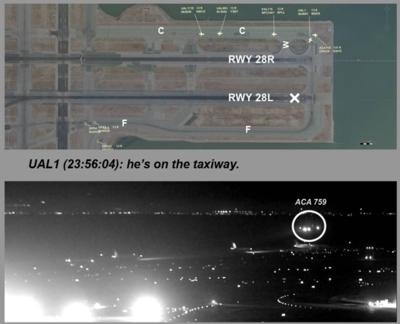Wed, Aug 09, 2017
Ground Surveillance System Could Prevent Aircraft From Landing On Taxiways
In 2011, the NTSB made a recommendation to the FAA to upgrade ground radar systems that would warn controllers when an airplane is lined up to land in the wrong place ... as happened recently in San Francisco when an Air Canada A320 nearly landed on a taxiway where four aircraft were waiting to take off.

At the time, the FAA disagreed with the recommendation according to government records, without even studying whether the solution was feasible.
Now, Bloomberg Technology reports that since the incident at KSFO July 7, the FAA has announced that over the past year, it has begun taking action on that safety recommendation, and testing on the system could begin in a few months. "We believe recent technological advances may now enable us to modify our ground surveillance systems to detect aircraft that are lined up to land on taxiways," the agency said Friday in statement emailed to Bloomberg.
The NTSB made the recommendation following a 2009 incident in which a Delta Airlines Airplane landed on a taxiway in Atlanta. In that case, there were no other airplanes on the taxiway, and the plane landed safely. The Board said that the crew's abilities were degraded by fatigue after an all-night flight.
The system that is being evaluated as a potential solution is ASDE-X, radar that warns controllers when an collision is possible between two airplanes on the ground, or an airplane and a ground vehicle. Then-FAA-Administrator Randy Babbitt told the NTSB at the time that ASDE-X would not be effective at its primary function if it were modified to warn against airplanes landing where they are not supposed to be.
Now, however, the FAA says recent software improvements in ASDE-X make it possible for the system to track arrivals. "The FAA since last year has been working to modify the systems so they will also capture aircraft that are lined up for taxiways," the agency said in the emailed statement. "The agency expects to begin testing some modified systems in a few months."
(NTSB image from file)
More News
He Attempted To Restart The Engine Three Times. On The Third Restart Attempt, He Noticed That Flames Were Coming Out From The Right Wing Near The Fuel Cap Analysis: The pilot repor>[...]
Make Sure You NEVER Miss A New Story From Aero-News Network Do you ever feel like you never see posts from a certain person or page on Facebook or Instagram? Here’s how you c>[...]
From 2009 (YouTube Edition): Leading Air Show Performers Give Their Best Advice for Newcomers On December 6th through December 9th, the Paris Las Vegas Hotel hosted over 1,500 air >[...]
Aero Linx: NASA ASRS ASRS captures confidential reports, analyzes the resulting aviation safety data, and disseminates vital information to the aviation community. The ASRS is an i>[...]
“For our inaugural Pylon Racing Seminar in Roswell, we were thrilled to certify 60 pilots across our six closed-course pylon race classes. Not only did this year’s PRS >[...]
 NTSB Final Report: Rutan Long-EZ
NTSB Final Report: Rutan Long-EZ ANN FAQ: Turn On Post Notifications
ANN FAQ: Turn On Post Notifications Classic Aero-TV: ICAS Perspectives - Advice for New Air Show Performers
Classic Aero-TV: ICAS Perspectives - Advice for New Air Show Performers ANN's Daily Aero-Linx (06.28.25)
ANN's Daily Aero-Linx (06.28.25) Aero-News: Quote of the Day (06.28.25)
Aero-News: Quote of the Day (06.28.25)



